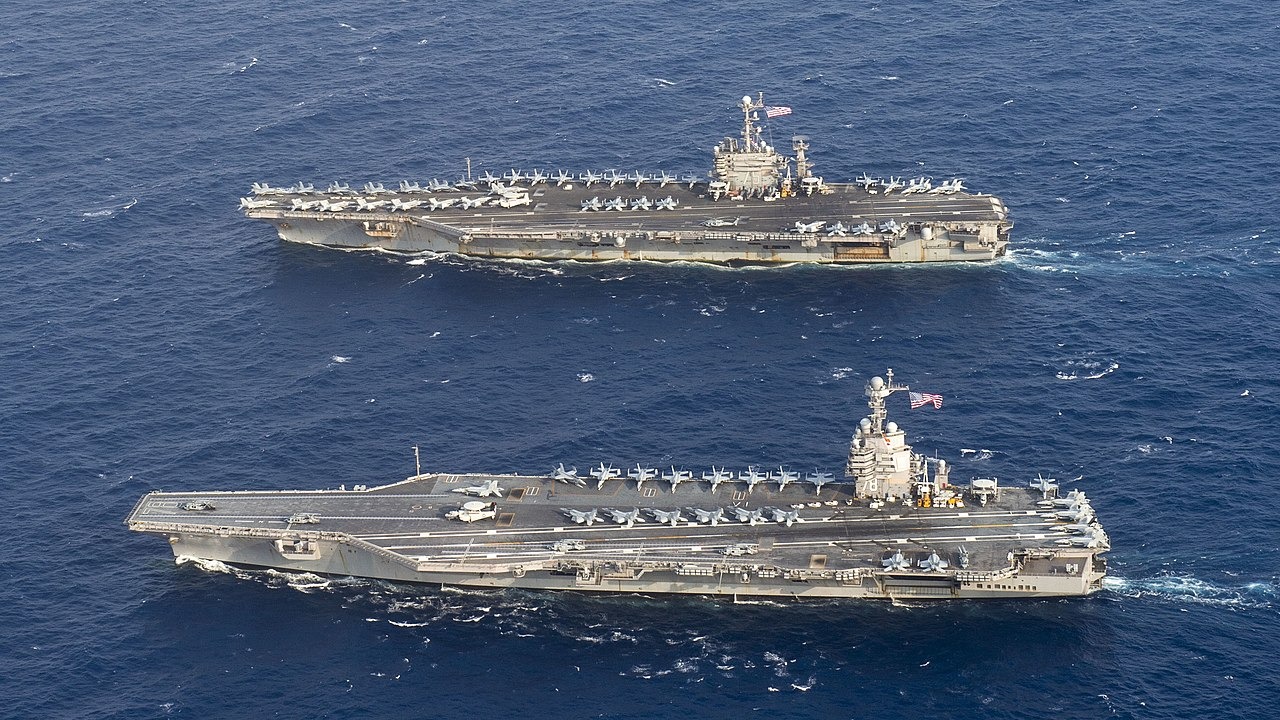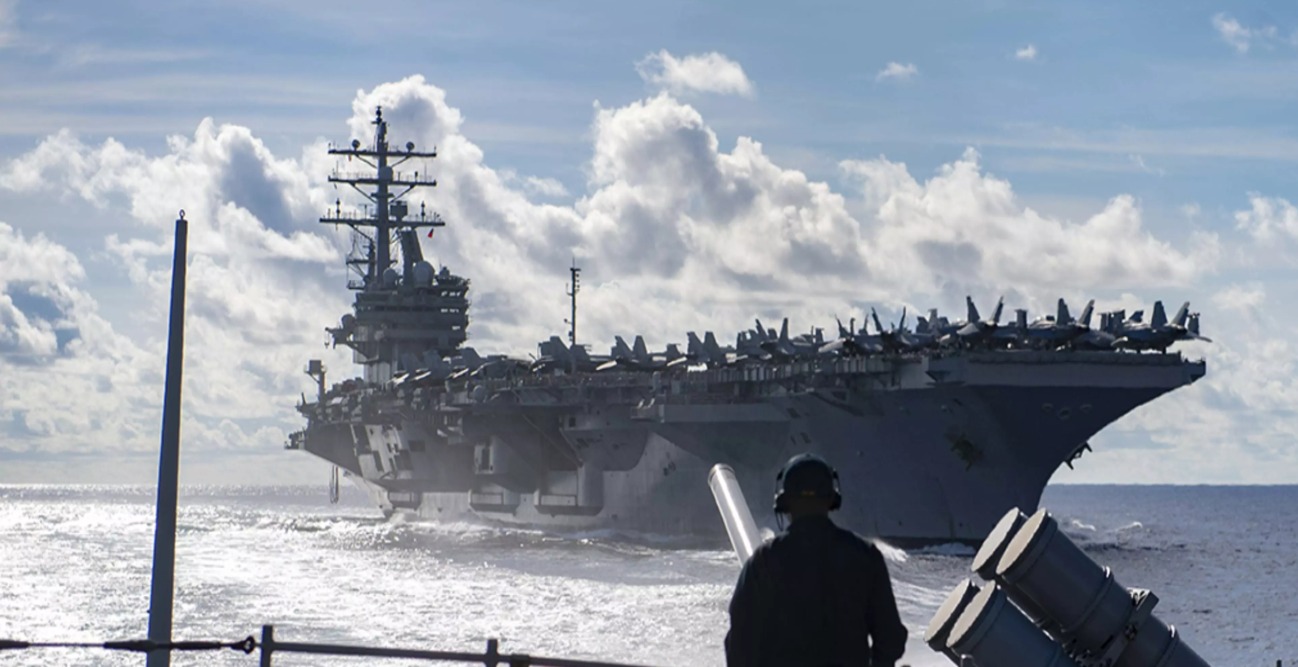With China developing substantial capabilities for detecting and attacking U.S. Navy surface ships with anti-ship missiles and other weapons in the Indo-Pacific, the Department of the Navy (DON), which includes the Navy and Marine Corps, has come out with an operating concept called Distributed Maritime Operations (DMO) to improve the ability of American naval forces to counter China’s maritime anti-access/area-denial (A2/AD) systems.
Though the DON keeps the details of the DMO classified, the Congressional Research Service (CRS) released a report on February 27 aimed at informing the U.S. legislators.
To the CRS, the following “appears” to be the “the key features” of the DMO.
• Dispersing Navy units over a larger area within the theater of operations so as to make it harder for an adversary to detect and target Navy units while still permitting Navy units to support one another and concentrate their fires on adversary targets.
• Spreading the Navy’s sensors and weapons across a wider array of ships and aircraft so as to reduce the fraction of the Navy’s sensors and weapons that would be lost due to the destruction of any Navy ship or aircraft (i.e., avoid “putting too many eggs into one basket”).
• Making greater use of longer-range weapons, unmanned vessels, and unmanned aircraft in support of the previous two points.
• Using resilient communication links and networking technologies to knit the resulting widely dispersed force of manned and unmanned ships and aircraft into a coordinated battle force that can withstand and adapt to enemy attacks on Navy communications and networks.
It may be noted here that every service in the U.S. has its own operating concept. The Air Force concept is Agile Combat Employment (ACE), and the Army concept is MultiDomain Operations (MDO). Even within the DON, the Marine Corps has a concept called Expeditionary Advanced Base Operations (EABO) that is complementary to DMO.
It is said that the services’ operating concepts have certain elements in common, including increased use of unmanned systems and the use of communications and networking technology to knit dispersed units together into coordinated battle forces.
Coming back to the DMO, the CRS report mentions some of the recent U.S. Navy Acquisition Programs. These are:
• Programs for acquiring longer-ranged weapons, such as the Maritime Strike Tomahawk (a new anti-ship variant of the Tomahawk cruise missile) and the Long-Range Anti-Ship Missile (LRASM).
• The Large Unmanned Surface Vessel (LUSV), which is to be equipped with a Vertical Launch System (VLS) for storing and firing anti-ship missiles and other weapons. LUSVs are intended to act as adjunct missile magazines for manned Navy surface combatants.
• The Medium Unmanned Surface Vessel (MUSV), which is to be equipped with radars or other sensors. MUSVs are intended to help form a distributed sensor network for supporting Navy operations.
• The light replenishment oiler (TAOL) shipbuilding program for building a new class of smaller oilers. TAOLs are intended to enhance the Navy’s ability to provide fuel and supplies to Navy ships that are operating in a more distributed manner across a wider sea area.
• The Medium Landing Ship (LSM) program for building a class of smaller amphibious ships. The LSM program is central to implementing EABO.
Not Enough?
Are these programs adequate enough? In fact, the CRS report contains many questions that it says the U.S. Congress could ask the Pentagon while deciding on the budget for the Navy in the coming months. Three of them are particularly noteworthy.
One, to what degree might the Navy’s ability to implement DMO be constrained over the next 5 to 10 years by limits on the number of long-range weapons in the Navy’s inventory? Under current Navy plans for procuring new weapons, how quickly would any such constraints be eased?
Two, what are the technical challenges and risks of the communications and networking technology needed for DMO? Does DMO adequately account for the possibility of wartime degradation in the network due to enemy attacks?
Three, to help implement DMO, some observers have suggested adding missile batteries to ships that currently do not have them, such as amphibious or auxiliary ships, or arming Littoral Combat Ships (LCSs) with missiles that have longer ranges than the missiles that LCSs currently carry. What are the relative merits of these proposals?
Overall, however, the U.S. Navy says that it has prepared itself well in the year 2023 in instilling a new sense of urgency in operations, acquisition, force development, and organizational transformation. While much more needs to be accomplished to get the service on a real war footing, the Navy’s recent achievements should not be dismissed, say Robert Holzer and Dmitry Filipoff in their review of the Navy.
They have quoted former Chief of Naval Operations (CNO) Admiral Michael Gilday saying at his retirement in August last year, “The Navy recognizes that this is a decisive decade—a decade during which command of the seas will determine the balance of power for the rest of this century. We are undergoing revolutionary changes in our plans, in our platforms, in capabilities, how we lead and support the men and women of Team Navy.”
Holzer and Filipoff have also noted how Secretary of the Navy Carlos Del Toro is also pushing the Navy to move faster in technology development and shipbuilding to pace the China threat and has launched several initiatives to improve the Navy’s rate of change and adaptation to this threat.
In a speech at Harvard University in September, the Secretary had apparently said: “The People’s Republic of China is building up its naval fleet at a rapid pace. In the 20 years since I left active duty, the PLA Navy has tripled in size and is on pace to have over 400 naval warships by 2030”.

Among these initiatives, two are said to be particularly significant. These are the Disruptive Capabilities Office (DCO) and a new Maritime Statecraft Initiative. The DCO is reportedly an acceleration cell for moving promising technologies, concepts, and capabilities rapidly through the Navy’s acquisition bureaucracy.
The statecraft initiative is seemingly to more effectively harness the collective power of the country’s various departments, agencies, and offices that focus on the oceans, environment, defense, and trade to counter China’s ascendant maritime position.
And, as China is considered to be the principal threat, efforts have been made to strengthen the U.S. naval presence in the Indo-Pacific through the testing of and experimentation with new operational concepts and technologies, and the fielding of new weapon systems. “The theme that we use at IndoPaCom is we have to think, act, and operate differently every day,” according to Admiral John Aquilino, head of U.S. Indo-Pacific Command (IndoPaCom).
One such operational concept that was introduced in the Indo-Pacific last year was the historic deployment of a flotilla of four unmanned surface vessels (USVs).
As part of Integrated Battle Problem 23.2, the prototype USVs Sea Hunter, Seahawk, Ranger, and Mariner deployed with the USS Carl Vinson (CVN-70) carrier strike group. The USVs transited the Pacific Ocean from the West Coast to Hawaii in August and then operated with the U.S. Seventh Fleet in Yokosuka, Japan.
The U.S. Navy engaged in several high-profile operations in the western Pacific in 2023 despite major demands for naval forces in other parts of the globe. In November 2023, naval forces conducted a multi-large deck event (MLDE) with the Japan Maritime Self-Defense Force (JMSDF).

Similarly, in 2023, the Navy raised multiple organizations, ranging from acquisition to readiness, to facilitate reform. The surface warfare community established the Naval Surface Readiness Group (SurfGru) Southwest in San Diego in December 2023. This command joins other SurfGrus in fleet concentration areas focused on improving maintenance and force generation.
This entity formally inserts the tactical expertise of surface warfare tactics instructors into acquisition and systems development. The SurfGru seeks to align fleet, program office, and resource sponsor efforts and provide recommendations on surface capability development.
According to Holzer and Filipoff, the U.S. Navy is also embarking on a major upgrade program to enhance the capabilities of the surface force. About 20 DDG-51 Flight IIA destroyers will go through the DDG MOD 2.0 program and be upgraded with the SEWIP Block III electronic warfare systems, SPY-6 radars, and Aegis Baseline 10 capability.
The refit is expected to take up to two years per warship, and the program is expected to cost about $17 billion. To manage the program, the Navy established a new program office (PMS 451) in September 2023.
However, there seems to be another side of the story. Here, the fundamental question is whether the U.S. has the industrial capacity to build what it plans. As the Washington Post has reminded us, there are now not enough skilled workers and materials to build and finish.
“On net, Congress isn’t increasing the Navy — the fleet, in fact, will shrink by a ship or two in 2028. It’s just padding the order books of a few big defense contractors”, it says.
Incidentally, the four public shipyards in the U.S. are said to be in poor health. “At the Navy’s four public shipyards, most of the piers, dry-docks, cranes and machine shops are in poor shape or past their useful life; modernizing them will likely take 30 years and $25 billion”, Washington Post says, quoting Jack Reed (D-R.I.), chairman of the Senate Armed Services Committee, “How will the Navy be able to maintain a larger fleet in the future when you can’t keep up with maintaining fewer than 300 ships today?”
Besides, the paper asks what is the point of ordering more ships if the Navy cannot find sailors to crew them. In 2023, the Navy is said to have finished its recruiting year 7,000 sailors short of its 37,700 target.
Considering all this, what the U.S. Navy needs today are not only new concepts, technologies, and weapons but also modernized shipyards, skilled workers, and sailors to serve on the warships so as to send a strong signal to China.
- Author and veteran journalist Prakash Nanda is Chairman of the Editorial Board – EurAsian Times and has commented on politics, foreign policy, and strategic affairs for nearly three decades. A former National Fellow of the Indian Council for Historical Research and recipient of the Seoul Peace Prize Scholarship, he is also a Distinguished Fellow at the Institute of Peace and Conflict Studies.
- CONTACT: prakash.nanda (at) hotmail.com
- Follow EurAsian Times on Google News




